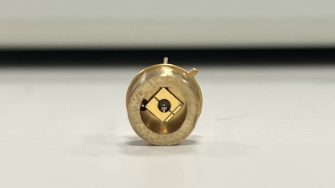Solar power at night on Earth and in orbit: A renewable reality
Two years ago, UNSW researchers made a major breakthrough with renewable energy
Two years ago, UNSW researchers made a major breakthrough with renewable energy

Two years ago, UNSW researchers made a major breakthrough with renewable energy, producing electricity from solar power during the night-time. They’re now taking their tech to space.
The team from the School of Photovoltaic and Renewable Energy Engineering, opens in a new window produced electricity from heat radiated as infrared light, in the same way the Earth cools by radiating its heat from the day’s sunlight into space after the sun sets.
A semiconductor device called a thermoradiative diode, composed of materials found in night-vision goggles, was used to generate power from the emission of infrared light.
The amount of power was small, 100,000 times less than that supplied by a solar panel, but it was an ‘unambiguous demonstration of electrical power’, according to team lead Professor Ned Ekins-Daukes.
The team’s findings were an exciting confirmation of a previously theoretical process.
Since then, they’ve started working with a new, more easily manufacturable material.
At night, the heat from sunlight radiates back into outer space in the form of infrared light. It’s the red, white and yellow regions displayed by a thermal imaging camera.
“In the same way that a solar cell can generate electricity by absorbing sunlight emitted from a very hot sun, the thermoradiative diode generates electricity by emitting infrared light into a colder environment. In both cases the temperature difference is what lets us generate electricity,” said Dr Phoebe Pearce at the time, one of the researchers on the project.
The research team believe the new technology could have a range of uses in the future by helping to produce electricity in ways not currently possible.
“In principle, it is possible for us to generate power in the way we have demonstrated just from body heat,” Prof. Ekins-Daukes said.
“Down the line, this technology could potentially harvest that energy and remove the need for batteries in certain devices – or help to recharge them. That isn’t something where conventional solar power would necessarily be a viable option.”
That could mean something like a wristwatch powered entirely by you.
At the opposite end of the spectrum for potential uses, the professor’s team is currently working on applying the technology to spacecraft like satellites.

Each day in low Earth orbit (where the International Space Station sits) lasts 90 minutes, split in half between daylight and darkness. Spacecraft are powered by solar cells but rely on batteries during eclipse conditions. The team is currently applying the technology to generate power for the spacecraft as it orbits in darkness.
“The first silicon solar cells were demonstrated in 1953 and by 1958 they were used on the first solar powered satellite,” Prof. Ekins-Daukes said.
“We now generate very large quantities of electricity from solar power for our homes using silicon solar cells, that technology which was first used in space.
“In a similar way, we intend to fly the thermoradiative diode in space within the next 2 years.”
As Australia’s best engineering faculty turns 75, there are just as many reasons why we’ve earned that title. Discover new stories weekly, celebrating the successes that have enabled progress for all.
